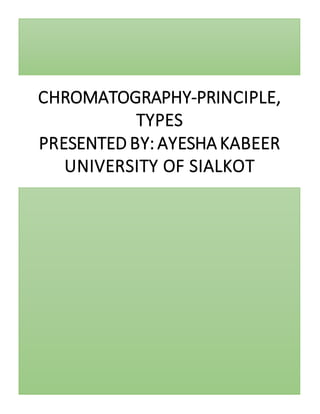
CHROMATOGRAPHY-PRINCIPLE, TYPES
- 1. CHROMATOGRAPHY-PRINCIPLE, TYPES PRESENTED BY: AYESHA KABEER UNIVERSITY OF SIALKOT
- 2. CHROMATOGRAPHY: Chromatography is a technique for separating mixtures into their components to analyze, identify, purify, and/or quantify the mixture or components. The components to be separated are distributed between two phases i.e. stationary phases and mobile phase. Principle: Chromatographic technique is based on different interactions of compounds with two phases i.e. mobile phase, stationary phase, as the compounds travels through the supporting medium. Mobile phase: a solvent that flows through the supporting medium. Stationary phase: a layer or coating on the supporting medium that interacts with the analytes. Supporting medium: a sold surface on which the stationary phase is bound or coated. Types: There are several types of chromatographic techniques’. 1. Paper chromatography 2. Affinity chromatography 3. Ion exchange chromatography 4. Size exclusion chromatography/gel filtration chromatography 5. Hydrophobic interaction chromatography 1. Paper chromatography: Paper chromatography is an analytical technique for separating and identifying both colored and colorless mixtures. In paper chromatography, the stationary phase is a very uniform absorbent paper. Cellulose (non-polar) in the form of paper sheets makes an ideal support medium where water is adsorbed to the cellulose fibers and forms the stationary hydrophilic phase.
- 3. Principle: The samples are subjected to flow by mobile liquid onto or through the stable stationary phase. The sample components are separated into fractions based on their relative affinity towards the two phases during their travel. Material used: 1. Jar or beaker 2. Lid 3. Distilled water 4. Graduated cylinder 5. Strips of filter paper 6. Assorted colors 7. Pencil 8. Ruler 9. Scissors 10. Tape Procedure: I. In the first step, chromatography strips are prepared through filter paper by using scissors. II. Then, the paper is placed in a jar containing a solvent such as ethanol or water then sealed. III. Then, a small concentrated spot of solution that contains the sample of the solute is applied to a strip of chromatography paper about 2 cm away from the base of the plate. IV. As the solvent rises through the paper, it meets the sample mixture which starts to travel up the paper with the solvent. V. Paper chromatography takes from several minutes to several hours.
- 4. Retention factor or value(Rf): In paper chromatography, the results are calculated by Rf value which is basically a distance travelled by a given component divided by the distance travelled by the solvent front. Rf= distance travelled by a given component÷ distance travelled by the solvent front If Rƒ value of a solution is zero, the solute remains in the stationary phase and thus it is immobile. If Rƒ value = 1 then the solute has no affinity for the stationary phase and travels with the solvent front. 2. Affinity chromatography: Affinity Chromatography is essentially a sample purification technique, used primarily for biological molecules such as proteins. It is a method of separating a mixture of proteins or nucleic acids (molecules) by specific interactions of those molecules with a component known as a ligand, which is immobilized on a support. For example: If a solution of a mixture of proteins is passed through the column, one of the proteins binds to the ligand based on specificity and high affinity whereas other proteins in the solution wash through the column because they are not able to bind to the ligand.
- 5. Principle: It is based on highly specific biological interactions between two molecules such as interactions between enzyme and substrate, receptor and ligand, or antibody and antigen. 3. Ion exchange chromatography: Ion exchange chromatography is a process by which a mixture of similar charged ions can be separated by using an ion exchange resin (i.e. cation exchanger and anion exchanger) which exchanges ions according to their relative affinities.
- 6. Principle: Its principle is based on the separation of molecules on the basis of their electrical charges. 4. Size exclusion chromatography: Size-exclusion chromatography (SEC), also called gel filtration or gel-permeation chromatography (GPC), uses porous particles to separate molecules of different sizes. It is generally used to separate biological molecules, and to determine molecular weights and molecular weight distributions of polymers. It is usually applied to large molecules or macromolecular complexes such as proteins and industrial polymers. When an aqueous solution is used to transport the sample through the column, the technique is known as Gel-filtration chromatography. On the other hand, when an organic solvent is used as a mobile phase, the technique is known as Gel-permeation chromatography. Size of pores in beads determines the exclusion limit (what goes through the beads and what goes around the beads) Principle: Its principle is based on the separation of molecules on the basis of their molecular weight.
- 7. 5. Hydrophobic interaction chromatography: Hydrophobic Interaction Chromatography is a separation technique that uses the properties of hydrophobicity to separate proteins from one another. This technique was initially known as salting out. In this type of chromatography, hydrophobic groups such as phenyl, octyl, or butyl, are attached to the stationary column.
- 8. Principle: Separation of substances is based on their varying strength of interaction with hydrophobic groups attached to an uncharged gel matrix. i.e. hydrophobic groups on proteins are sufficiently exposed to bind to the hydrophobic groups on the matrix.